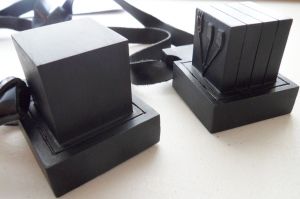The decals are mounted in such a way that under Jewish law they are considered adhering to, but not part of, the ritual ornament.
Jerusalem, August 8 – Israel’s Chief Rabbis endorsed a new ruling this morning that allows the use of certain decals on Tefillin, a decision that is expected to help many low-income, religiously observant families generate much-needed revenue by selling highly visible ad space on the ritual objects.
Religiously observant Jews are disproportionately represented in the lower rungs of the socioeconomic ladder, and tend to have larger families to support. Chief Rabbis Yitzhak Yosef and David Lau issued a teshuva, an essay answering a question on a point of Jewish law, approving a certain new method of displaying images on the outside of Tefillin worn on the head, a ruling that gives the green light to using the front and back sides of head-Tefillin as advertising space. Arm-Tefillin, which are in any case harder to see and often covered by a sleeve or prayer shawl, are not included in the endorsement.
While under normal circumstances Tefillin are disqualified if they are composed of materials other than the hide of a kosher animal, the method in question, pioneered by an entrepreneur from the northern city of Tzfat (Safed), does not technically violate that stricture, as the decals are mounted in such a way that under Jewish law they are considered adhering to, but not part of, the ritual ornament, which must be remain painted black. The two letters shin, in relief, one on the left side and one on the right, are still visible, but advertisers may choose to pay for the top square, as well.
“We hope this ruling opens the door to some betterment of the financial situation for so many,” the Rabbis wrote. “The economic well-being of the people has always been a primary consideration in questions of Halacha, with more desperate circumstances dictating that we strip away ancillary principles in favor of the basic law, in this case that there is no essential reason not to support the use of this method.”
Rabbis Lau and Yosef explained that the ruling applies universally, and not only to low-income Tefillin-wearers, since many people might be ashamed to publicly display indications of their poverty, and eschew the ads. Allowing everyone to participate in the Tefillin-advertising market would remove that stigma and enable those who need it most to avail themselves of the income opportunity without embarrassment.
Advertisers are already gearing up to take advantage of the new space. “It’s rare that frontal advertising, as opposed to mere sponsorship, is welcomed inside the synagogue,” said Phil Actery, of the ad agency Shelyad-Shelrosh. “I’m sure graphic designers throughout the industry welcome the challenge of creating arresting images that effetively convey our clients’ messages.” Actery said his firm has begun exploring campaigns with prominent advertisers, including makers of swimwear, online gambling sites, and contraceptive manufacturers.





